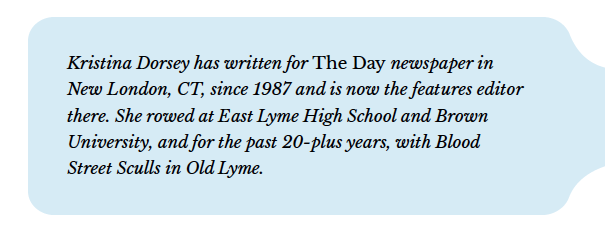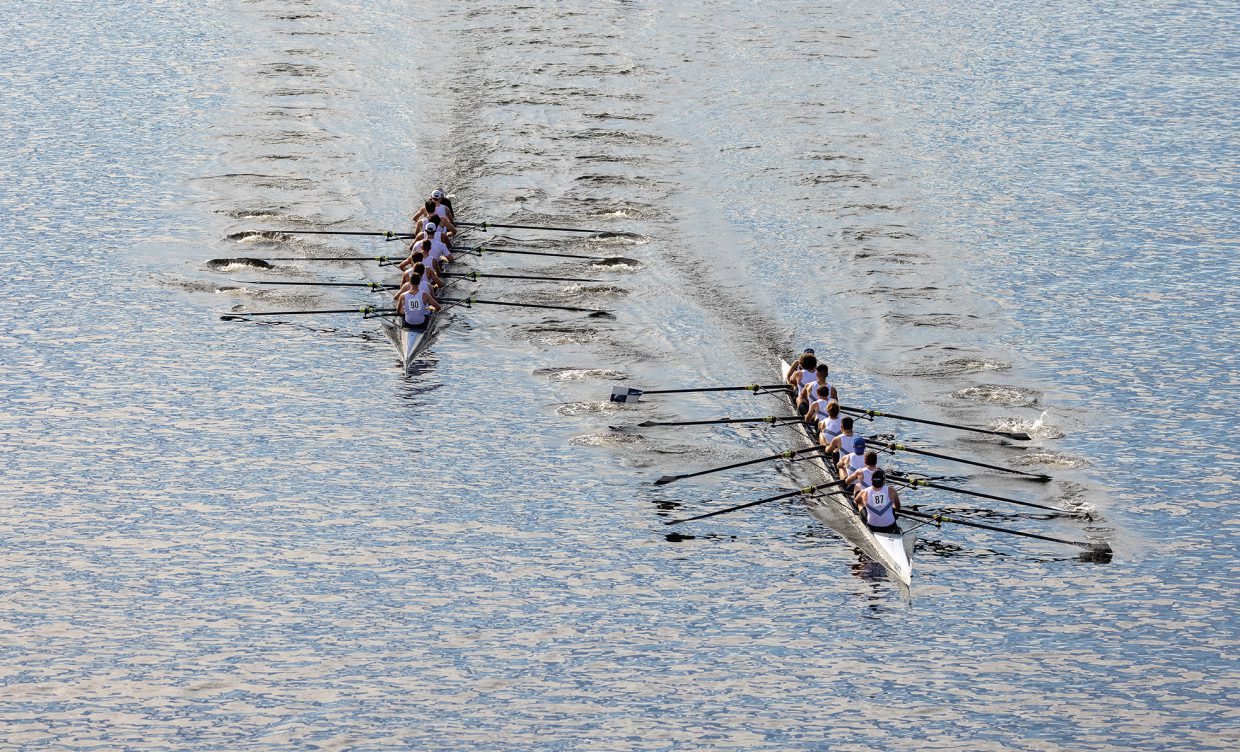
A Tufts University, on left, and UConn eight approach the finish line in the Head of the Riverfront Regatta on the Connecticut River in Hartford, CT.

Springfield, Massachusetts, was the epicenter of rowing in the US in the late 1800s, said rowing historian Thomas E. Weil. Even into the 1900s, back when professional rowing existed, national rowing championships were held on the Connecticut River there.
Collegiate teams, though, soon became the dominant force on the river. The rowers were young men until, as women’s sports blossomed on a university level, female students joined in.
Community programs have grown up as well, with adults and high schoolers taking part in competitive and recreational programs.
In recent years, adaptive rowing has become a common sight, too, with people who have a disability or injury taking to the water.
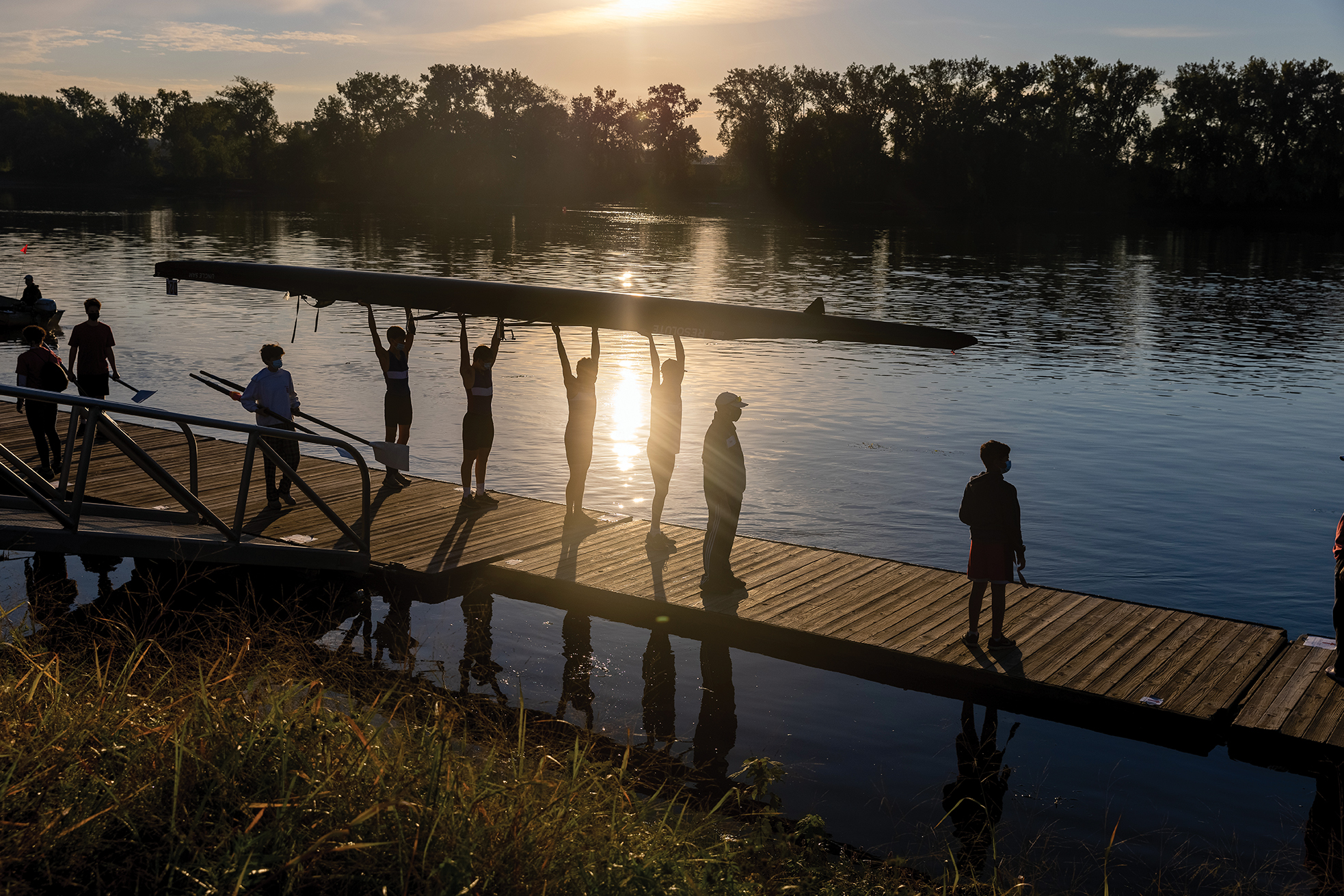
A boat crew carries their shell to the Connecticut River against the backdrop of the rising sun preparing for the races of the day.
Miles of Rowable Water
In rowing, flat water is the ideal—no waves, no wind, no disturbance to inhibit the shell from moving smoothly and swiftly forward.
The Connecticut River, at 410 miles, boasts a range of conditions along the way, but the best is arguably near Dartmouth College in Hanover, New Hampshire.
The water is so perfect that elite international teams go there to practice. Dartmouth has hosted Australian national team rowers and the US women’s and men’s teams over the years.
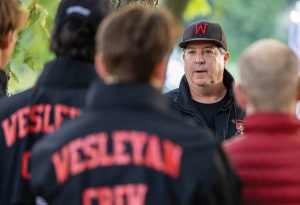
Phil Carney, head coach of Wesleyan University men’s crew, addresses the team before the Head of the Riverfront Regatta in Hartford, CT.
Wyatt Allen, men’s heavyweight rowing coach at Dartmouth, said, “It’s flat and protected, so when it’s windy out, there are still very good rowing conditions.... The other thing is the distance you can row. We have over 40 miles of rowable water from our boathouse—that’s really unusual. So it’s a good place to come and get a lot of mileage.”
In addition, by summertime, there’s essentially no current there (Allen says it feels like a 40-mile lake), and that region doesn’t get the kind of heat other parts of the country do.
The sport of crew has a long history at Dartmouth, as it does at so many other schools. At Dartmouth, students began rowing in the early 1800s on Lake Mascoma and started practicing on the Connecticut River in 1937.
The colleges along the Connecticut River tend to have very healthy crew programs. On a typical day during the school year, Dartmouth, for instance, has 120 student athletes on the river, in its men’s heavyweight and lightweight programs and its women’s program. At the IRA (Intercollegiate Rowing Association) Championship in 2021, Dartmouth’s Heavyweight Men’s Varsity 8 finished third in the country.
The River Farther South
Wesleyan University, meanwhile, practices lower on the Connecticut River, on the section near its Middletown, Connecticut, campus. The school, which generally has three 8s of men and three 8s of women, boasts a strong program; among its recent successes was the men winning the New England Rowing Championships in 2019.
Down at that section of the river, Wesleyan men’s crew head coach Phil Carney said, “We can go as far as we want to any day of the week. We can go 20 miles to Hartford, we can go 20 miles to the Long Island Sound roughly, and it’s beautiful.”
The river is wide, though, so the water can get choppy when it’s windy.
“Yesterday, probably half of the practice was rough, and half of it was awesome just because of the way the river twists and turns and the way the wind was blowing,” Carney said in September. “It was a south wind—there are spots that are great and there are spots that are terrible. Over time, you can kind of figure it out. We can get pretty good water pretty much every day if we go in the right direction.”
Carney hasn’t just coached on the Connecticut River; he also rowed there when he was a student at Trinity College in Hartford, graduating in 1985.
From Collegiate to Community Rowing
Community rowing often develops near colleges, and former rowers and coaches have been known to establish those opportunities for adults and kids.
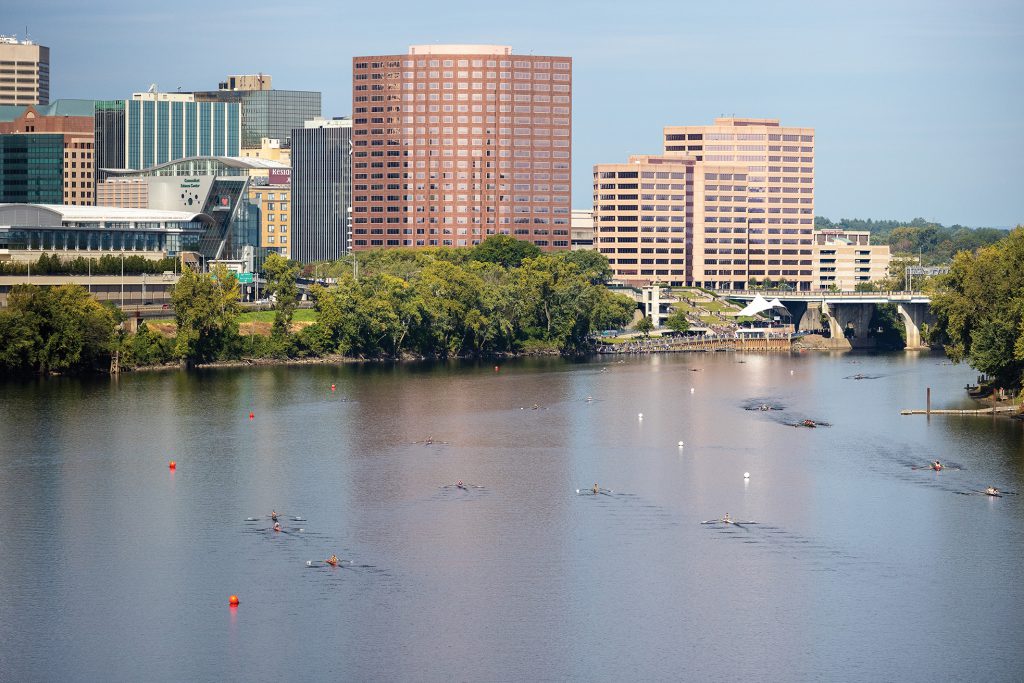
Crews row between the orange and white markers of the course toward the Hartford skyline and finish line next to Riverfront Plaza just before Founders Bridge.
Carney, from Wesleyan, collaborated with Joe Marfuggi, who had worked in development for the University of Connecticut Health Center, to get a Hartford community rowing program off the ground.
The resulting Riverfront Recapture boathouse, which opened in 2002, and rowing program developed when a highway interchange was being redesigned and organizers wanted to make sure the highways would no longer cut off Hartford and East Hartford residents from the Connecticut River, according to Bryan Pape, director of Riverfront’s rowing program.
“The overarching theme was connecting people to the river, making it accessible, and giving people reasons to take advantage of this great natural resource we have right in the city. The rowing program became a pretty natural extension from that mission,” Pape said.
Riverfront has grown and prospered over the years, with competitive and recreational components for youths and adults. During the peak of summer, between 150 and 200 people come through Riverfront’s various coached programs, classes, and clinics, with another 40 or so scullers using their own boats or signing up to use club equipment.
Riverfront has also developed an adaptive rowing program through a partnership with Mount Sinai Rehabilitation Hospital. They formed the Connecticut Adaptive Rowing Program (CARP) and offer adaptive rowing programs as well as military veteran kayaking.
Riverfront boasts a variety of CARP adaptive rowing equipment. There are, for instance, double shells in which one fully able-bodied person can row with one adaptive athlete. Those boats are wide for stability and designed with removable cockpits so athletes without the use of their legs can replace a sliding seat with a stationary one, Pape said.
Flooding and Debris
While the Connecticut River has its assets, it also serves up some challenges to rowers. In the spring, there are inevitably floods caused by snowmelt upstream, bringing debris with it.
The crews learn how to adjust to these issues. Carney said the Wesleyan athletes get good at rowing when the river is moving fast, and the coxswains become adept at managing the debris.
The Riverfront boathouse, meanwhile, was designed to accommodate and withstand the spring flooding up to 30 feet, Pape said. The boats and equipment inside the boat bays, though, have to be moved out of the house when the waters rise past a certain point; the boats are put on trailers and driven up the nearby hill to avoid rising waters.
Women’s Rowing
As with other sports, competitive collegiate rowing was a men’s domain before women got the opportunity to do it. A particular boon to women’s sports was Title IX, the 1972 law that prohibits sex-based discrimination in any school or education program that gets federal funds.
But women’s colleges were ahead of the curve. At Smith College in Northampton, Massachusetts, for instance, women’s rowing dates back to not long after the college opened in 1875. Karen Klinger, who rowed at Smith before graduating in 1987 and who coached there from 1997 to 2017, said that rowing became a varsity sport at Smith in 1972. That’s when intercollegiate competition began, although students there were rowing long before that.
The students had to do an activity in fall, winter, and spring, so there might be 300 to 400 young women, wearing dresses and pantaloons, in wooden boats on the water, she said.
While the focus then was more on elements like posture and perfect timing in their strokes, Klinger said with a laugh that, with boats moving side by side, “You can’t tell me they didn’t race each other.”
(Speaking of the competitive spirit, Klinger mentioned a news clipping she has from 1933 about the Smith crew challenging the men’s crew from Yale to a race; when Smith administrators learned about it, though, they put a stop to the proposal, saying the school didn’t engage in intercollegiate competition.)
Klinger said she thinks the biggest change is when women’s rowing was designated an emerging sport by the NCAA, becoming NCAA-sanctioned in 1997.
Whatever the impetus, women’s collegiate rowing has flourished not only on the Connecticut River but across the country.
Clare Doyle, who is the current head rowing coach at Smith College (where, in 2018, the school had its best finish at the prestigious Head of the Charles in Boston, coming in fifth), spoke about the appeal of the sport to women—but her description could apply to all rowers: “I think it’s the team nature of it. It’s the kind of sport where it’s all about the work you put in, your willingness and ability to do it together.…It’s all about the collective, and I think that’s a really empowering space to be in as a student athlete. You are part of something bigger than yourself, and everybody is committed to the work and the mission of the team.”

A Wesleyan University women’s eight sprints to the finish line of the Head of the Riverfront Regatta.
